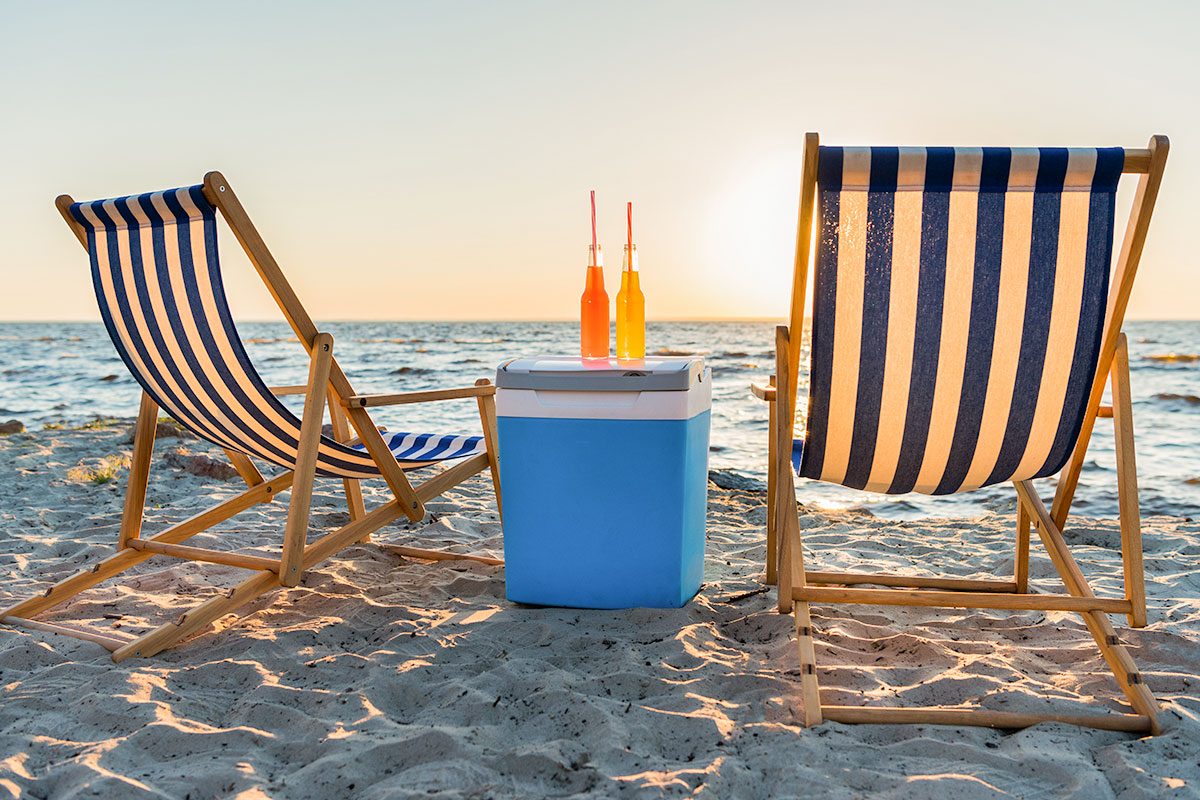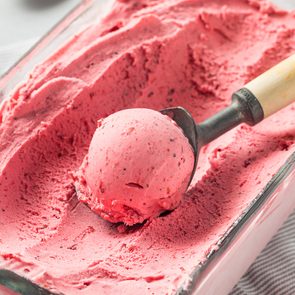Here's exactly how to pack, maintain and clean your cooler—according to catering pros who've seen it all (including meat-juice frosting)

Goodbye, Melted Ice! This Is the Best Way to Pack a Cooler

It’s the opening to a beautiful rom-com: a couple deeply in love, seated on a picnic blanket laid out with sparkling wine, fresh flowers and perfectly plated snacks. Maybe he’s about to propose?! But first, it’s time to eat. They pull the cooler closer, throw open the lid and find … soggy sandwiches, lukewarm potato salad and a single, floating pickle. Just like that, the rom-com becomes a horror movie. If you think I’m being dramatic, think again, because it turns out that knowing the best way to pack a cooler is crucial to having a successful outing with food.
Whether you’re heading to a picnic, beach day or tailgate party, packing a cooler the right way can be the difference between gourmet al fresco dining and a sad, squishy mess. “As a chef who’s handled everything from intimate garden parties to large-scale outdoor events, I can say that how you pack and manage a picnic cooler can make or break your meal, both from a food-safety standpoint and your overall experience,” says Dennis Littley, a classically trained chef with more than 40 years of experience.
And yes, you can mess it up, even if you majored in Tupperware Tetris. That’s why we asked Littley and Brian Strayer, director of catering and catering operations for Rubio’s Coastal Grill, to share their best tips for keeping your next picnic chill—in both senses of the word. I am also sharing some of my own personal advice, since I spent nearly a decade as a catering manager and definitely have some opinions on this topic. Here’s exactly how to pack (and maintain, and clean) your cooler like a pro so you can say goodbye to melted ice … and hello to sandwich nirvana.
Get Reader’s Digest’s Read Up newsletter for more food tips, humor, cleaning, travel, tech and fun facts all week long.
What’s the best way to pack a cooler?

When I worked as a catering manager, I used coolers in a professional capacity on the daily, and I’ve seen all the mistakes and then some. My personal favorite? The time I opened a cooler to find that someone (Brian, ahem) stacked raw hamburger patties in the same cooler as cupcakes. The items were wrapped in plastic, but still, there should never be even a chance of frosting and beef juice co-mingling.
To prevent this and other common mistakes, here are the steps you need to follow to make sure your meal stays safe, tasty and free of surprise meat icing.
1. Prechill the cooler
Before you start throwing in soda cans and watermelon wedges, think about where your cooler has been. No, this isn’t a mindfulness exercise—it’s thermodynamics. “I always recommend prechilling the cooler if it’s been sitting in a warm garage or trunk because that residual heat works against you,” says Littley. You can do this by filling the cooler with ice or ice packs for about 30 minutes before loading it up.
Another option? Bringing it inside your air-conditioned home the day before. Bonus: This also gives you a chance to check for stray spiders, ancient napkins or that weird ketchup fossil from last summer’s barbecue.
That said, Strayer takes a more relaxed view, especially if the cooler has been stored in a climate-controlled location. “A cooler does its job with or without chilling it first,” he says. So pick your fighter—but know that a prechilled cooler gives you a solid head start against the heat.
2. Start with a base layer of ice
Both Littley and Strayer agree: Always begin with a level layer of ice or ice packs at the bottom of the cooler. This creates your chill foundation and helps evenly cool everything above it. “Then, pack the food on top, and [later] add more ice on top of the food,” Strayer says. Think of it like a frosty sandwich (except you don’t eat the cooler).
For less mess, go with frozen ice packs instead of bagged or loose ice—though all types of ice will work equally well at keeping things cold. Just be prepared for some puddles if you go the loose-ice route. Your grapes may end up swimming.
3. Use durable, waterproof containers
We all love a good reuse moment, but your old takeout containers probably aren’t up for this challenge. Strayer recommends using “containers that won’t break down due to ice and humidity. And never use paper.” Plastic or Tupperware works best—bonus points if it seals tight and stacks neatly.
Warning: Use zip-top bags carefully, as they can get punctured or pop open unexpectedly.
4. Layer by weight and temperature sensitivity
Remember that heavy stuff smushes the light stuff. You know this. Your grapes know this. Your deviled eggs really know this.
Put heavier items or anything that needs extra chilling at the bottom, then layer lighter and more stable items. “Raw meats on the bottom, then chilled salads or dairy, and things like fruits or drinks on top,” Littley says. This keeps the most temperature-sensitive (and potentially dangerous) foods closest to the ice.
If you’re worried about transporting raw meat, consider precooking it so all you have to do is warm it up on-site. FYI, here’s how long cooked meat lasts when chilled.
5. Then organize by meal or frequency of use
No one wants to dig through icy chicken to find the string cheese. And if you’re packing for kids, you know they’re going to be rooting around for snacks every 12 seconds. So save your sanity by grouping items logically: snacks with snacks, mains with mains, drinks with drinks. Littley advises keeping the high-traffic items—like juice boxes or that fruit salad your aunt insists she “soaked in love” (read: vodka)—near the top for easy access.
If you have only one cooler, just do your best. But if you’re planning a big day or feeding a crowd, consider bringing two coolers: one for food, one for drinks. Or one for grown-ups and one for kids.
6. Don’t overfill it
If the lid won’t close, cold air escapes. And without the right ice-to-food ratio, you’re basically carrying around a room-temperature lunchbox. Not ideal.
Instead, Strayer says to give everything a little breathing room—and if you’ve got more food than space, grab a second cooler. Your sandwiches (and your stomach) will thank you.
7. Tape a list of the contents to the lid
One of my top organizational hacks when I worked in catering was making sure each cooler and bag was labeled clearly with the contents, what it was needed for, what order to use it in and how to prep it. Your picnic probably doesn’t require that ninja level of planning, but Littley does suggest jotting down “a quick list of what’s inside and taping it to the lid.”
Not only does it save time, but it also keeps the cold air inside longer, since you won’t have to open the cooler 10 times while shouting, “Did anyone remember the mayo?!”
Strayer agrees, but advises keeping it simple: “A Post-it note should suffice.”
How should you maintain the cooler during the outing?

Cooler packed? Great. You’re not done. Keeping it cold throughout your adventure is a full-time job—kind of like babysitting a large, rectangular toddler with a temperature problem.
Keep it in the shade
“Keep the cooler in the shade or under a table, not in the trunk of a car or in direct sun,” Littley says. This seems obvious, but you’d be shocked by how many people lovingly prep and chill their food—then roast it in a sunlit parking lot for three hours. Shade means longer-lasting ice, which also means less “Does this shrimp smell funny?”
Don’t drain the meltwater too soon
Water sloshing around your food might feel gross, but that chilly bath actually helps. “That icy bath can help keep things cold for a while,” says Littley. Only drain it if the water has warmed up and is no longer doing its frosty job.
Replenish the ice as needed
No one likes to babysit ice, but if you want to keep that pasta salad from turning into a biology experiment, you might have to. “I would recommend looking after two hours and surveying where the ice level is,” Strayer says. “After that, check it hourly to see if you need to add more ice.”
Plan to pop in a few extra ice packs every couple of hours—more often if you’ll be opening the cooler a lot, if the day is extra warm or if it’s out in the sun.
Keep the lid closed
Every time you open the lid, your cooler sighs and loses its chill (literally and emotionally). Keeping the lid closed is Cooler 101, but every kid I know ignores it. (Some adults too.) So be intentional. Be strategic. Be that person who yells, “SHUT THE COOLER!” like it’s your only job.
How should you clean the cooler?
You made it through your event. You didn’t give anyone food poisoning. You deserve a parade. But first, clean that cooler. The faster you clean it out after you get home, the easier it will be. Do not, under any circumstances, leave it for “later.” You will regret all your life choices. Ask me how I know.
Toss or store leftovers ASAP
When you get home, deal with the leftovers immediately. Don’t let them stew in a lukewarm puddle of regret. Perishables like meats, mayo-based salads or anything you’d be nervous to eat at room temperature should probably get tossed—even the best cooler has limits when it comes to food safety.
Less risky items like cut fruit or sealed snacks? Give them a once-over and pop them in the fridge if they still look fresh.
Drain the ice
Next, get rid of all the meltwater and ice. Pro tip: Do this on your front lawn—it cuts down on mess and gives your plants a little extra hydration. (You’re multitasking! Look at you.)
Wash and deodorize
If your cooler didn’t house raw meat and looks relatively clean, Strayer suggests keeping it simple: “Hose it out, and let the sun do its job by air-drying it upside down in the sunshine.”
But if it’s harboring sticky spills, meat juice or a rogue baked bean or two, you’ll need a deeper clean. “I use warm soapy water and a little baking soda to scrub out any residue or lingering odors,” Littley says. Rinse well, and let it air-dry completely. If that shrimp cocktail smell is still hanging around, splash in a little white vinegar, rinse again, and repeat until it’s fresh.
Dry it completely
Last tip? Make sure your cooler is totally dry before closing the lid and putting it back in storage. Otherwise, you’ll be in for a bad mildewy surprise the next time you break it out. And nobody wants the sequel to the cooler horror movie.
RELATED:
- Here’s the Only Place You Should Store Your Ketchup
- The Newest Costco Dessert Is a Must for Your Next Barbecue
- Here’s Which City Eats the Most Hot Dogs—By a Lot!
About the experts
|
Why trust us
At Reader’s Digest, we’re committed to producing high-quality content by writers with expertise and experience in their field in consultation with relevant, qualified experts. We rely on reputable primary sources, including government and professional organizations and academic institutions as well as our writers’ personal experiences where appropriate. We verify all facts and data, back them with credible sourcing and revisit them over time to ensure they remain accurate and up to date. Read more about our team, our contributors and our editorial policies.
Sources:
- Brian Strayer, director of catering and catering operations for Rubio’s Coastal Grill Inc.; phone interview, July 1, 2025
- Dennis Littley, classically trained chef and founder of Ask Chef Dennis; email interview, July 2, 2025























